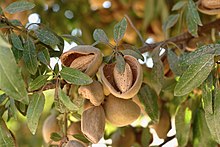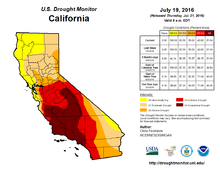Almonds in California

Although almonds are not native to California, a hot, dry Mediterranean climate and developed water infrastructure create ideal conditions for commercial cultivation of the crop.[1] The state produces 80% of the world's almonds and 100% of the United States’ commercial supply.[2]
Economic impact[]
Almonds were California's third most valuable agricultural product in 2016, accounting for $5.2 billion (about 11%) of agricultural output.[3] Almond production has increased significantly in recent years; by weight, production more than tripled from 703 million pounds in 2000 to 2.27 billion pounds in 2017.[4] Prices rose over the same period, fueled in part by overseas demand. Newly planted almond acreage has displaced more traditional cash crops, such as cotton.[5]

In addition to consumer demand, the industry's growth has benefitted from mechanization. During the harvesting process, tree shakers are used to aggressively shake each almond tree, causing the nuts to fall to the ground. This reduces the need for labor relative to other crops, which has attracted farmers who are concerned with shortages of migrant workers.[1]
A 2014 report commissioned by the Almond Board of California, an industry group, found that the industry directly employed 21,000 people and indirectly supported an additional 83,000 jobs statewide. Including indirect effects, the industry added about $11 billion to the state's GSP.[6]
Exports[]
Almonds are California's most valuable export crop. Farmers exported $4.5 billion worth to foreign countries in 2016, about 22% of the state's total agricultural exports. The majority of these exports went to the European Union, China and India.[3] While the EU is the largest consumer, the latter two countries are expanding markets where the state's Almond Board has actively marketed the nuts as a healthy snack.[5]
As part of the 2018 China–United States trade war, China has imposed a 50% tariff on almonds. As a result, some Chinese businesses have resorted to importing almonds from other producers in Africa and Australia.[7]
Environmental issues[]
Bees[]

Like many crops, almond cultivation requires cross-pollination. Although almonds can be pollinated by many insects, commercial almond farming is heavily dependent on honey bees. Commercial almond growers may rent hives during the blooming season to ensure pollination success.[8] Starting in 2006, California almond growers began to suffer losses due to colony collapse disorder, a poorly understood phenomenon resulting in the decline of bee populations.[1] While this increased pollination expenses for many growers, high demand for almonds created an incentive to transport bees from across the United States to California. The state's bee population has since partly recovered, and in 2018 accounted for more than half of all bee colonies in the United States.[1]
Water[]

California suffered a severe drought from 2011 to 2017. In addition to economic consequences for the state's almond growers, the industry came under criticism for its water use. As of 2015, almond cultivation consumed about 10% of the state's water.[9] Furthermore, almond acreage increased by 14% from 2007 to 2014, while almond irrigation increased by 27%.[10] Critics have pointed out that the state's 6,000 almond farmers use roughly 35 times the amount of water as the 466,000 residents of Sacramento.[11]
To supplement reduced deliveries from the state's water system, many almond farmers increased groundwater pumping, which can unsustainably deplete aquifers and cause land subsidence.[11]
Almond production fell somewhat a result of the drought, contributing to higher prices and dampening consumer demand.[1] To compensate, many farmers removed older, less-productive almond trees and replaced them with newer plantings that use less water. Since these trees will take half a decade to become productive, some farmers have expressed concerns about a future almond surplus.[1]
Waste products[]
In the 2015/2016 crop year, the California almond industry produced over 1.5 million metric tons of hulls and over 0.5 million metric tons of shells. Historically, these byproducts have been used for livestock feed and bedding, or as fuel for cogeneration plants. However, declining demand for these uses combined with an increasing supply of almonds has created a mismatch. The Almond Board of California, an industry association, has researched ways to incorporate almond byproducts into other industries such as food, automotive, and pharmaceutical.[2]
One possible use investigated by the Board is bioenergy feedstock. For example, biochar made from almond shells can be integrated into automobile and plane tires, allowing them to better resist changing temperatures. Biochar can also be used to make stronger, biodegradable plastic goods such as garbage bags and flower pots.[2]
A similar sustainability initiative has been "whole orchard recycling". At the end of their productive life, whole almond trees are ground up and the remains are integrated back into the soil, which retains the tree's nutrients. This process also increases the soil's ability to hold water.[2]
See also[]
References[]
- ^ a b c d e f Bjerga, Alan. "California Almonds Are Back After Four Years Of Brutal Drought". bloomberg. Retrieved November 7, 2018.
- ^ a b c d Davis, Chelsea. "The Billion-Dollar California Almond Industry's Blossoming Future". PasteMagazine. Retrieved November 7, 2017.
- ^ a b California Agricultural Statistics Review, 2016-2017 (PDF), California Department of Food and Agriculture, retrieved 21 Dec 2018
- ^ 2018 California Almond Objective Measurement Report (PDF), National Agricultural Statistics Service, Pacific Region, 5 July 2018, retrieved 21 Dec 2018
- ^ a b Pierson, David (12 Jan 2014). "California farms lead the way in almond production". Los Angeles Times. Retrieved 21 Dec 2018.
- ^ Sumner, Daniel A.; Matthews, William A.; Medellín-Azuara, Josué; Bradley, Adrienne, The Economic Impacts of the California Almond Industry (PDF), University of California Agricultural Issues Center, retrieved 21 Dec 2018
- ^ Craymer, Lucy. "U.S. Almond Farmers Are Reeling From Chinese Tariffs". wallstreetjournal. Wall Street Journal. Retrieved 5 November 2018.
- ^ Jimenez, Ilana. "Bees And Almonds: How Are Almond Trees Pollinated". gardeningknowhow. Retrieved November 7, 2018.
- ^ Gonzales, Richard. "How Almonds Became A Scapegoat For California's Drought". npr. Retrieved 7 November 2018.
- ^ Pickett, Mallory. "In The Midst Of Drought, California Farmers Used More Water For Almonds". Forbes. Retrieved 9 December 2018.
- ^ a b Kasler, Dale; Reese, Phillip; Sabalow, Ryan. "California almonds, partly blamed for water shortage, now dropping in price". The Sacramento Bee. Retrieved 21 December 2018.
- Agriculture in California
- Almond production
